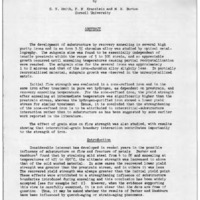-
Title
-
Experiments on Substructure in Iron
-
Report Number
-
ASD-TDR-63-324 p. 111-140
-
Creator
-
Smith, G. V.
-
Kranzlein, P. M.
-
Burton, M. S .
-
Corporate Author
-
Cornell University
-
Laboratory
-
Directorate of Materials and Processes
-
Date
-
1963
-
Date Issued
-
1963-04
-
Extent
-
30
-
Identifier
-
AD0406794
-
Format
-
1 online resource
-
Abstract
-
The development of substructure by recovery annealing in severa high purity irons and in an iron 3.5% chromium alloy was studied by optical metallography. The subgrain size was found to be essentially independent of tensile prestrain within the range of 5 to 30% strain, and no appreciable growth occurred until annealing temperatures causing partial recrystallization were reached . The subgrain size for the several irons was approximately 1 to 2 microns and that of the iron-chromium alloy slightly less. In partially recrystallized material, subgrain growth was observed in the unrecrystallized matrix. Initial flow strength was evaluated in a zone-refined iron and in the same iron after treatment in pure wet hydrogen, as dependent on prestrain, and recovery annealing temperature . For the zone-refined iron, the yield strength after annealing at intermediate temperature was significantly higher than the prestrain stress, whereas the hydrogen-purified iron showed a lower yield stress for similar treatment. Hence, it is concluded that the strengthening of the zone-refined iron is to be attributed to interstitial-substructure
interaction rather than to substructure as has been suggested by some earlier work reported in the literature. The effect of grain size on flow strength was also studied, with results showing that interstitial-grain boundary interaction contributes importantly to the strength of iron.
-
Description
-
The development of substructure by recovery annealing in severa high purity irons and in an iron 3.5% chromium alloy was studied by optical metallography. The subgrain size was found to be essentially independent of tensile prestrain within the range of 5 to 30% strain, and no appreciable growth occurred until annealing temperatures causing partial recrystallization were reached . The subgrain size for the several irons was approximately 1 to 2 microns and that of the iron-chromium alloy slightly less. In partially recrystallized material, subgrain growth was observed in the unrecrystallized matrix. Initial flow strength was evaluated in a zone-refined iron and in the same iron after treatment in pure wet hydrogen, as dependent on prestrain, and recovery annealing temperature . For the zone-refined iron, the yield strength after annealing at intermediate temperature was significantly higher than the prestrain stress, whereas the hydrogen-purified iron showed a lower yield stress for similar treatment. Hence, it is concluded that the strengthening of the zone-refined iron is to be attributed to interstitial-substructure
interaction rather than to substructure as has been suggested by some earlier work reported in the literature. The effect of grain size on flow strength was also studied, with results showing that interstitial-grain boundary interaction contributes importantly to the strength of iron.
-
Distribution Classification
-
1
-
Distribution Conflict
-
No
-
DTIC Record Exists
-
No
-
Illinois Tech Related
-
No
-
Photo Quality
-
Complete
-
Report Availability
-
Full text available
-
Type
-
article
 article06
article06